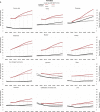Demographic shift disproportionately increases cancer burden in an aging nation: current and expected incidence and mortality in Hungary up to 2030
- PMID: 30214314
- PMCID: PMC6121756
- DOI: 10.2147/CLEP.S155063
Demographic shift disproportionately increases cancer burden in an aging nation: current and expected incidence and mortality in Hungary up to 2030
Abstract
Background: Population aging is a common demographic pattern in developed countries, and aging increases the risk of cancer. The disproportionately high cancer burden, as a consequence, is especially pronounced in Central and Eastern European countries, including Hungary.
Methods: We summarized current and projected future cancer incidences and mortalities utilizing data from the last two decades. Predictions are based on cancer incidence and mortality collected between 1996 and 2015 in Hungary. In addition to the crude rates, data were age standardized to the European standard population (ESP) of 2013, ESP of 1976, and local census of 2011.
Results: The lifetime probability of developing cancer and cancer-related mortality has already reached 56.9% and 27.6% in men, respectively, and 51.9% and 21.7% in women. Between 2016 and 2030, the total population is expected to shrink by 6%, while the number of 60-year olds and above will grow by 18%. This will lead to a 35% increase in cancer incidence and 30% increase in cancer death among 65-85-year olds. Joinpoint regression identified the period 2007-2015 as starting point for this coming increase in new cases. In women, lung and breast cancer will increase yearly by 1.9% and 1.7%, respectively, between 2016 and 2030, while in men, the prostate and colorectal cancer rates will increase yearly by 3.6% and 2.1%.
Conclusion: In the aging population of Hungary, cancer incidence will increase considerably over previous projections. Although a large portion of the most rapidly rising cancers are avoidable by implementing public health programs, a substantial portion remains inevitably incurable.
Keywords: aging; biostatistics; breast cancer; cancer; colon cancer; lung cancer; prostate cancer.
Conflict of interest statement
Disclosure The authors report no conflicts of interest in this work.
Figures





Comment in
-
Demographic shift disproportionately increases cancer burden in an aging nation: current and expected incidence and mortality in Hungary up to 2030.Clin Epidemiol. 2018 Dec 13;10:1865-1868. doi: 10.2147/CLEP.S195330. eCollection 2018. Clin Epidemiol. 2018. PMID: 30588117 Free PMC article. No abstract available.
Similar articles
-
Estimates of cancer incidence and mortality in Europe in 1995.Eur J Cancer. 2002 Jan;38(1):99-166. doi: 10.1016/s0959-8049(01)00350-1. Eur J Cancer. 2002. PMID: 11750846
-
Population aging and cancer: a cross-national concern.Cancer J. 2005 Nov-Dec;11(6):437-41. doi: 10.1097/00130404-200511000-00002. Cancer J. 2005. PMID: 16393477
-
Revising Incidence and Mortality of Lung Cancer in Central Europe: An Epidemiology Review From Hungary.Front Oncol. 2019 Oct 23;9:1051. doi: 10.3389/fonc.2019.01051. eCollection 2019. Front Oncol. 2019. PMID: 31709174 Free PMC article.
-
[Current state and future perspectives of oncology care in Hungary based on epidemiologic data].Orv Hetil. 2005 Jul 17;146(29):1519-30. Orv Hetil. 2005. PMID: 16136773 Review. Hungarian.
-
Cancer incidence and mortality in the Greater Poland Region-Analysis of the year 2010 and future trends.Rep Pract Oncol Radiother. 2014 Jul 9;19(5):296-300. doi: 10.1016/j.rpor.2014.04.001. eCollection 2014 Sep. Rep Pract Oncol Radiother. 2014. PMID: 25184053 Free PMC article. Review.
Cited by
-
miRNA Expression Signatures of Therapy Response in Squamous Cell Carcinomas.Cancers (Basel). 2020 Dec 28;13(1):63. doi: 10.3390/cancers13010063. Cancers (Basel). 2020. PMID: 33379285 Free PMC article.
-
Demographic shift disproportionately increases cancer burden in an aging nation: current and expected incidence and mortality in Hungary up to 2030.Clin Epidemiol. 2018 Dec 13;10:1865-1868. doi: 10.2147/CLEP.S195330. eCollection 2018. Clin Epidemiol. 2018. PMID: 30588117 Free PMC article. No abstract available.
-
Gene Expression Indicates Altered Immune Modulation and Signaling Pathway Activation in Ovarian Cancer Patients Resistant to Topotecan.Int J Mol Sci. 2019 Jun 5;20(11):2750. doi: 10.3390/ijms20112750. Int J Mol Sci. 2019. PMID: 31195594 Free PMC article.
-
Smell Detection Agent Optimisation Framework and Systems Biology Approach to Detect Dys-Regulated Subnetwork in Cancer Data.Biomolecules. 2021 Dec 27;12(1):37. doi: 10.3390/biom12010037. Biomolecules. 2021. PMID: 35053185 Free PMC article.
-
Development and In Vivo Application of a Water-Soluble Anticancer Copper Ionophore System Using a Temperature-Sensitive Liposome Formulation.Pharmaceutics. 2020 May 20;12(5):466. doi: 10.3390/pharmaceutics12050466. Pharmaceutics. 2020. PMID: 32443790 Free PMC article.
References
-
- United Nations, DESA/Populations Division World Population Prospects: the 2015 Revision. [Accessed February 1, 2017]. Available from: https://esa.un.org/unpd/wpp/Publications/.2015.
-
- Ferlay J, Soerjomataram I, Dikshit R, et al. Cancer incidence and mortality worldwide: sources, methods and major patterns in GLOBOCAN 2012. Int J Cancer. 2015;136(5):E359–E386. - PubMed
-
- Ferlay J, Steliarova-Foucher E, Lortet-Tieulent J, et al. Cancer incidence and mortality patterns in Europe: estimates for 40 countries in 2012. Eur J Cancer. 2013;49(6):1374–1403. - PubMed
-
- Dusek L, Muzik J, Maluskova D, et al. Cancer incidence and mortality in the Czech Republic. Klin Onkol. 2014;27(6):406–423. - PubMed
LinkOut - more resources
Full Text Sources
Other Literature Sources

